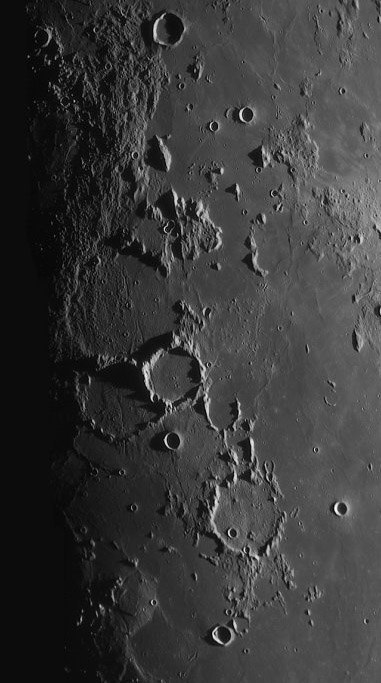
image by Stefan Lammel, Uxbridge, England. The putative ray, from Gambart to Guericke.
All fresh craters have rays, demonstrating that during the crater-forming process some rock fragments receive more energetic ejections than others. Did the formation of impact basins also create rays? I would expect so, but it is sort of hard to tell. Crater rays are most conspicuous where they are on dark mare surfaces, but most of the mare lavas erupted after the formation of the last basins. Thus much of the ejecta of the Imbrium Basin has been buried by lavas of Frigoris, Serenitatis, Vaporum, Insularum and Procellarum. Areas where the ejecta are thicker than average (or higher in elevation) have escaped marial burial. These areas - the Haemus Mountains and the Lost Peninsula - are mostly near Imbrium. One 700 km long nearly continuous deposit of Imbrium ejecta does exist. It extends from near Copernicus, passes Gambart, and extends on to Fra Mauro, disappearing just south of Guericke. Light discoloration of the surface of Mare Nubium suggests that the ejecta might even have continued another 200 km, but has since been buried by lavas. Is this a ray, or just the only remaining piece of what was once a laterally continuous ejecta deposit?
Technical Details:
27-Mar-07 22:19-23.22 UT. 10in f4.8 Newtonian, DMK 21AF04, 4x PowerMate, green filter, Registax v4, PSE 5, 1/30s, 1300/4000, MAP: 19-44x 64×64, part of a 3 image mosaic.
Related Links:
Rükl plates 42 & 43
Stefan’s website
Part of this image, at full resolution, appeared as LPOD on June 11, 2007.
Yesterday's LPOD: A Swath of Mystery
Tomorrow's LPOD: Brightness Amid the Gray
COMMENTS?
Register, Log in, and join in the comments.



